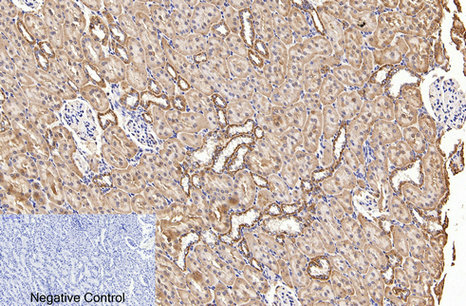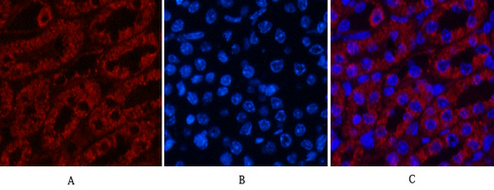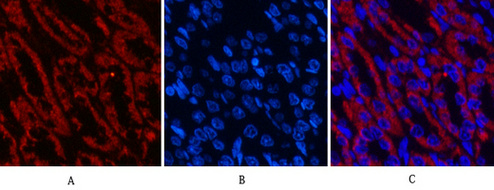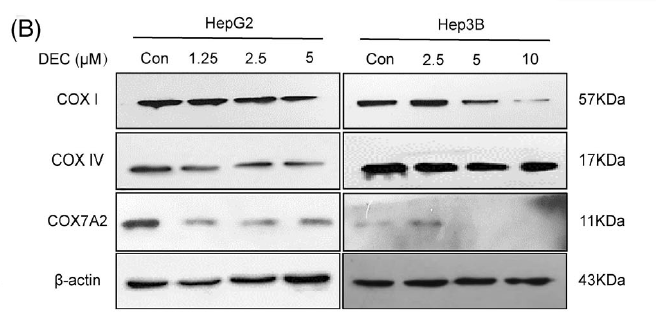COX IV Monoclonal Antibody(6C8)
- Catalog No.:YM3033
- Applications:WB;IHC;IF;
- Reactivity:Human;Rat;Mouse
- Target:
- COX IV
- Fields:
- >>Oxidative phosphorylation;>>Metabolic pathways;>>Cardiac muscle contraction;>>Thermogenesis;>>Non-alcoholic fatty liver disease;>>Alzheimer disease;>>Parkinson disease;>>Amyotrophic lateral sclerosis;>>Huntington disease;>>Prion disease;>>Pathways of neurodegeneration - multiple diseases;>>Chemical carcinogenesis - reactive oxygen species;>>Diabetic cardiomyopathy
- Gene Name:
- COX4I1
- Protein Name:
- Cytochrome c oxidase subunit 4 isoform 1, mitochondrial
- Human Gene Id:
- 1327
- Human Swiss Prot No:
- P13073
- Mouse Gene Id:
- 12857
- Mouse Swiss Prot No:
- P19783
- Rat Gene Id:
- 29445
- Rat Swiss Prot No:
- P10888
- Immunogen:
- Recombinant Protein of Cytochrome c oxidase subunit 4 isoform 1, mitochondrial
- Specificity:
- The antibody detects endogenous COX IV protein.
- Formulation:
- PBS, pH 7.4, containing 0.5%BSA, 0.02% sodium azide as Preservative and 50% Glycerol.
- Source:
- Monoclonal, Mouse
- Dilution:
- WB 1:1000-3000 IF 1:200 IHC 1:50-300
- Purification:
- The antibody was affinity-purified from mouse ascites by affinity-chromatography using specific immunogen.
- Storage Stability:
- -15°C to -25°C/1 year(Do not lower than -25°C)
- Other Name:
- COX4I1;COX4;Cytochrome c oxidase subunit 4 isoform 1, mitochondrial;Cytochrome c oxidase polypeptide IV;Cytochrome c oxidase subunit IV isoform 1;COX IV-1
- Observed Band(KD):
- 15kD
- Background:
- Cytochrome c oxidase (COX) is the terminal enzyme of the mitochondrial respiratory chain. It is a multi-subunit enzyme complex that couples the transfer of electrons from cytochrome c to molecular oxygen and contributes to a proton electrochemical gradient across the inner mitochondrial membrane. The complex consists of 13 mitochondrial- and nuclear-encoded subunits. The mitochondrially-encoded subunits perform the electron transfer and proton pumping activities. The functions of the nuclear-encoded subunits are unknown but they may play a role in the regulation and assembly of the complex. This gene encodes the nuclear-encoded subunit IV isoform 1 of the human mitochondrial respiratory chain enzyme. It is located at the 3' of the NOC4 (neighbor of COX4) gene in a head-to-head orientation, and shares a promoter with it. Pseudogenes related to this gene are located on chromosomes
- Function:
- function:This protein is one of the nuclear-coded polypeptide chains of cytochrome c oxidase, the terminal oxidase in mitochondrial electron transport.,similarity:Belongs to the cytochrome c oxidase IV family.,tissue specificity:Ubiquitous.,
- Subcellular Location:
- Mitochondrion inner membrane ; Single-pass membrane protein .
- Expression:
- Ubiquitous.
The nature compound dehydrocrenatidine exerts potent antihepatocellular carcinoma by destroying mitochondrial complexes in vitro and in vivo 2022 Feb 02. WB Human
Mutation of IDH1 aggravates the fatty acid‑induced oxidative stress in HCT116 cells by affecting the mitochondrial respiratory chain. Molecular Medicine Reports Mol Med Rep. 2019 Apr;19(4):2509-2518 WB Human 1:1000 HCT116 cell
Immunogenic Radiation Therapy for Enhanced Antitumor Immunity via a Core–Shell Nanosensitizer-Mediated Immunosuppressive Tumor Microenvironment Modulation. ACS Nano Jin-Xiang Chen IF Mouse 4T1 cell-xenograft
- June 19-2018
- WESTERN IMMUNOBLOTTING PROTOCOL
- June 19-2018
- IMMUNOHISTOCHEMISTRY-PARAFFIN PROTOCOL
- June 19-2018
- IMMUNOFLUORESCENCE PROTOCOL
- September 08-2020
- FLOW-CYTOMEYRT-PROTOCOL
- May 20-2022
- Cell-Based ELISA│解您多样本WB检测之困扰
- July 13-2018
- CELL-BASED-ELISA-PROTOCOL-FOR-ACETYL-PROTEIN
- July 13-2018
- CELL-BASED-ELISA-PROTOCOL-FOR-PHOSPHO-PROTEIN
- July 13-2018
- Antibody-FAQs
- Products Images

- Immunogenic Radiation Therapy for Enhanced Antitumor Immunity via a Core–Shell Nanosensitizer-Mediated Immunosuppressive Tumor Microenvironment Modulation. ACS Nano Jin-Xiang Chen IF Mouse 4T1 cell-xenograft
.jpg)
- Zhang, Yanqiong, et al. "A discovery of clinically approved formula FBRP for repositioning to treat HCC by inhibiting PI3K/AKT/NF-κB activation." Molecular Therapy-Nucleic Acids19 (2020): 890-904.

- Immunofluorescence analysis of Hela cell. 1,AF-10 Polyclonal Antibody(red) was diluted at 1:200(4° overnight). COX IV Monoclonal Antibody(6C8)(green) was diluted at 1:200(4° overnight). 2, Goat Anti Rabbit Alexa Fluor 594 Catalog:RS3611 was diluted at 1:1000(room temperature, 50min). Goat Anti Mouse Alexa Fluor 488 Catalog:RS3208 was diluted at 1:1000(room temperature, 50min).

- Western blot analysis of lysates from 1) COS7,2) 3T3,3) Hela cells, (Green) primary antibody was diluted at 1:1000, 4°over night, Dylight 800 secondary antibody(Immunoway:RS23910)was diluted at 1:10000, 37° 1hour. (Red) Actin β Polyclonal Antibody (Immunoway:YT0099) antibody was diluted at 1:5000 as loading control, 4° over night,Dylight 680 secondary antibody(Immunoway:RS23720)was diluted at 1:10000, 37° 1hour.

- Immunohistochemical analysis of paraffin-embedded Rat-kidney tissue. 1,COX IV Monoclonal Antibody(6C8) was diluted at 1:200(4°C,overnight). 2, Sodium citrate pH 6.0 was used for antibody retrieval(>98°C,20min). 3,Secondary antibody was diluted at 1:200(room tempeRature, 30min). Negative control was used by secondary antibody only.

- Immunofluorescence analysis of Mouse-kidney tissue. 1,COX IV Monoclonal Antibody(6C8)(red) was diluted at 1:200(4°C,overnight). 2, Cy3 labled Secondary antibody was diluted at 1:300(room temperature, 50min).3, Picture B: DAPI(blue) 10min. Picture A:Target. Picture B: DAPI. Picture C: merge of A+B

- Immunofluorescence analysis of Rat-kidney tissue. 1,COX IV Monoclonal Antibody(6C8)(red) was diluted at 1:200(4°C,overnight). 2, Cy3 labled Secondary antibody was diluted at 1:300(room temperature, 50min).3, Picture B: DAPI(blue) 10min. Picture A:Target. Picture B: DAPI. Picture C: merge of A+B

- The nature compound dehydrocrenatidine exerts potent antihepatocellular carcinoma by destroying mitochondrial complexes in vitro and in vivo 2022 Feb 02. WB Human



